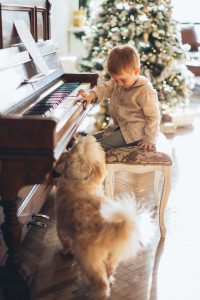18 October 2020
Dogs are an important part of our lives and for children, they can be an excellent way of teaching responsibility and empathy for others. Having a dog can also boost mental and physical health for all of the family as it forces us to be sociable and go outside for walks which gives us exercise and fresh air!
Although dogs and children can have great and long-lasting friendships, it is important as adults to take responsibility of the interactions between children and your dog. Not all children know the proper way to greet dogs or how to interact with them safely, a dog can cause serious harm without intending to.

Top tips for children and dogs:
- Never allow children to force themselves on a dog, whether giving affection or playing, especially if a dog moves away from the situation.
- Teach your child to understand that dogs sometimes need quiet time too, give space and let the dog relax.
- It is important to supervise dogs and children at all times, even the most patient dogs have their limits and accidents can happen anytime.
- Teach children how to be around young dogs, running around will encourage chasing and potentially biting from puppies, explain how to redirect this into a toy or encourage a calmer game.
- Remember to remind children avoid touching a dog that is sleeping or eating, even gentle dogs may not tolerate small children around food or may become startled while sleeping.
- Always remind children to seek owner permission before approaching or touching a dog, not all dogs are friendly, some can be nervous or may have medical issues and rushing in can create a dangerous situation.
Top tips for your dog your new baby:
- Ensure your dog’s training is up to date – sit, stay, down will all be necessary to create space and boundaries.
- Practice leaving your dog for short periods of time if not used to it – you will need to check on baby regularly and separation anxiety is not helpful.
- Get your dog used to unfamiliar objects like prams and cots.
- Practice ‘leave it’ command so that you dog will learn not to touch baby toys or other items if dropped or left out.
- If you will soon have baby only areas it is important to start enforcing this straight away – using baby gates or ‘out’ commands will help to create these spaces.
- Ensure your dog’s vaccines and other treatments are up to date.
- Introductions should be as calm and quiet as possible to avoid your dog getting over excited – use calm and quiet voices but remember to be strong on your commands.
Facebook – naturaldogfoodcompany
Twitter – @Natural_DogFood
Instagram – naturaldogfoodco
